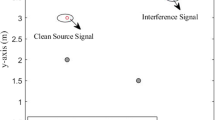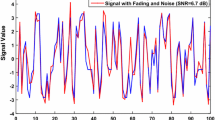Abstract
Functional networks (FNs) have shown excellent performance in probability, statistics, engineering applications, etc., but so far no methods of direct sequence estimation (DSE) for communication systems using FN have been published. The paper presents a new DSE approach using FN, which can be applied to cases with plural source signal sequence, short sequence or even the absence of training sequence. The proposed method can estimate the source sequence directly from the observed output data without training sequence and pre-estimating the channel impulse response. Firstly, a multiple-input multiple-output FN (MIMOFN), in which the initial input vector is devised via QR decomposition of receiving signal matrix, is adopted to solve the special issue. Meantime, a design method of the neural function for this special MIMOFN is proposed. Then, the learning rule for the parameters of neural functions is trained and updated by back-propagation learning algorithm. Finally, a simulation experiment is performed, the feasibility and accuracy of the method are showed from the experimental results, and some special simulation phenomena of the algorithm are observed.












Similar content being viewed by others
Explore related subjects
Discover the latest articles, news and stories from top researchers in related subjects.References
Robet S, Lutz L, Wolfgang HG (2001) Noncoherent sequence estimation combined with noncoherent adaptive channel estimation. http://www.lit.lnt.de/papers/ew00cr.pdf
Pinchas M, Bobrovsky BZ (2007) A novel HOS approach for blind channel equalization. IEEE Trans Wirel Commun 6(3):875–886
Abrar S, Nandi AK (2010) Blind equalization of square-QAM signal: a multimodulus approach. IEEE Trans Commun 58(6):1674–1685
Ruan X, Jiang X, Li C (2012) A novel method of Bussgang-type blind equalization in high-order QAM systems. J Electron Inf Technol 34(8):2018–2022
Ruan X, Zhang Y (2014) Blind sequence estimation of MPSK signals using dynamically driven recurrent neural networks. Neurocomputing 129:421–427
Ruan X, Zhang Y (2012) Blind optical baseband signals detection using recurrent neural network based on continuous multi-valued neurons. Acta Opt Sin 32(11):1-10
Ruan X, Zhang Z (2011) Blind detection of QAM signals using continuous hopfield-type neural network. J Electron Inf Technol 33(7):1600–1605
Castillo E, Gutiérrez JM, Hadi AS, Lacruz B (2001) Some applications of functional networks in statistics and engineering. Technometrics 43(1):10–24
Iglesias A, Arcay B, Cotos JM, Taboada JA, Dafonte C (2004) A comparison between functional networks and artificial neural networks for the prediction of fishing catches. Neural Comput Appl 13:21–31
Zhou Y, He D, Nong Z (2007) Application of functional network to solving classification problems. World Acad Sci Eng Technol 12:12–24
Emad AE, Asparouhov O, Abdulraheemd AA et al (2012) Functional networks as a new data mining predictive paradigm to predict permeablility in a carbonate reservoir. J Expert Syst Appl Int J 39(12):10359–10375
Alonso-Betanzos A, Castillo E, Fontenla-Romero O, Sáchez-Maroño N (2004) Sheer strength prediction using dimensional analysis and functional networks. In: ESANN’2004 proceedings: European symposium on artificial neural networks Bruges (Belgium), pp 251–256
Castillo E (1998) Functional networks. Neural Process Lett 7:151–159
Rajasekaran S (2004) Functional networks in structural engineering. J Comput Civil Eng 18(2):172–181
Shen J, Ding Z (2000) Direct blind MMSE channel equalization based on second-order statistics. IEEE Trans Signal Process 48(4):1015–1022
Acknowledgements
The authors would like to acknowledge the financial support of this work from the National Natural Science Foundation of China (NSFC) (Grant Nos. 61671329, 61201426, 61501331), the Zhejiang Provincial Natural Science Foundation of China (Grant Nos. LQ16F010010 and LY16F010016), the Scientific Research Project of Education Department of Zhejiang Province of China (Grant Nos. Y201327231 and Y201430529). The authors also appreciate anonymous reviewers for their valuable and insightful comments, which were helpful for improving the paper.
Author information
Authors and Affiliations
Corresponding author
Rights and permissions
About this article
Cite this article
Ruan, X., Tan, Y., Cui, G. et al. Direct sequence estimation: a functional network approach. Neural Comput & Applic 30, 977–985 (2018). https://doi.org/10.1007/s00521-016-2720-y
Received:
Accepted:
Published:
Issue Date:
DOI: https://doi.org/10.1007/s00521-016-2720-y




